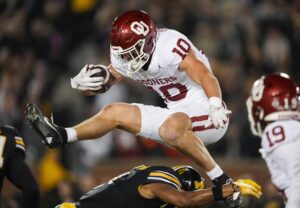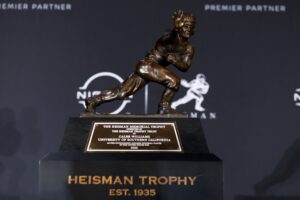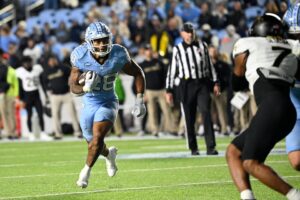Eight former Buckeyes represented Ohio State this past weekend in Indianapolis and gave NFL Scouts a lot to talk about. Ohio State sent the seventh most players of any college, and the second most by a B1G team, behind Michigan. After four days of both mental and physical examinations, NFL Scouts have a better idea of the talent players possess. Ohio State had players at the combine every day who measured and performed exceptionally well. Here is the Ohio State NFL Combine Recap.
Ohio State NFL Combine Recap
Pat Elflein
Pat Elflein was the first Buckeye to represent Ohio State at the combine and started off well. While his performance wasn’t the strongest, he proved to NFL Scouts that he is still a safe pick. Elflein’s history shows that he is hard working and willing to do anything to win, including two All-B1G honors, a Rimington Award, and a National Championship. If scouts decide to pass on Elflein, they will be making the same mistake colleges made when they passed on the three-star recruit in 2012.
Cameron Johnston
Next up on Friday night was Cameron Johnston. The Aussie punter only participated in the 40-yard dash, which he ran a 4.92, placing him 3rd among three participants. Stats like these really don’t say much about specialists, except maybe to give them a little extra pre-draft hype. Specialists also rarely go before day three, so any hype they can get helps. One major problem scouts have with Johnston is his kicking style. Rugby style punters are not common in the NFL and without a lot of hang-time, he may also lose some touch backs he would’ve gotten in college. Even if he is not taken on draft day, Johnston will still be able to receive an undrafted free agent deal from some team.
Curtis Samuel
Curtis Samuel stole most of the limelight this weekend for Ohio State after his 40-yard dash. Samuel ran a 4.31, second only to John Ross’ combine record 4.22. Samuel’s time is the fastest time at the combine in Ohio State history, and ties Trae Waynes, Justin King, and Deon Butler for the fastest time of any B1G athlete. He also finished in the top five in the bench press and vertical jump. The problem with Samuel is that while he is a very skilled player, he has yet to hone in on one particular position. He is very similar to Jalin Marshall last year where he can do a little bit of everything. The biggest difference is that Samuel is a much better athlete all-around than Marshall was last year.
Noah Brown
After leaving Ohio State much earlier than most people expected, Noah Brown had a decent day at the combine. He proved his strength in the bench press, getting 19 reps and tying for second among receivers. Brown only participated in two other events, the three cone drills and the 20 yard shuttle, which he did not shine in. The reason scouts have been hesitant with Brown is because of his lack of experience. Brown only had one year where he actually started, and caught 33 of his 52 targets throughout college. To go along with this inexperience, Brown also lacks deep speed and only caught three passes over 20 yards. This was seen throughout all of the 2016 season when J.T. Barrett seemed to never be able to find anyone open downfield. Brown is definitely a work-in-progress, but his height and ability to grab jump balls could help teams needing a redzone target.
Raekwon McMillan
Heading into the 2016 season, Raekwon McMillan was expected to have another great season. He followed his junior year of 119 tackles, four for losses, and 1.5 sacks with 102 tackles, seven for losses, and two sacks. He was a finalist for the Butkus Award in 2015 after winning the high school Butkus Award in high school. McMillan finished in the Top 10 for linebackers in the 40-yard dash, bench press, and broad jump. The most notable performance he put up on Sunday was his 4.61 40-yard dash, ranking him third among linebackers. One factor that worked in McMillan’s favor is how Jabrill Peppers performed. Peppers measured much smaller than he was in college which worked against a lot of the hype he had coming into the combine. McMillan proved that with some professional conditioning, he can be a starter in the NFL.
Marshon Lattimore
Marshon Lattimore only participated in three competitions, but finished in the top three in all of them. This was likely because of hamstring issue, something he struggled with in college. A 4.36 second 40-yard dash, 38.5 inch vertical jump, and an 11′ broad jump however proved Lattimore is a first round caliber player. Even with only one year of experience under his belt, Lattimore was getting some of the most attention of any defensive back on Sunday. This is likely because despite his limited experience, he faced some of the best receivers in the country throughout the year. He was only targeted 35 times in 2016, and was given 14 deflected passes along with four interceptions. Lattimore will likely compete at Pro Day on March 23rd to boost his value even more.
Gareon Conley
Conley was the second of three Ohio State defensive backs to declare for the draft. He was overshadowed by Malik Hooker and Lattimore most of the season, but still put up very impressive numbers. Conley had a mixed day at the combine. He put up great standards in the broad jump and 10’9″, a solid vertical of 37″, but only benched the bar 11 times and ran a 4.44 40-yard dash. While a 4.44 40-yard dash is still very good, with times like Ross’ 4.22 and Samuel’s 4.31, it may cause a bit of a concern. However, Conley still has a solid track record and has proven he can hang with some of college’s top receivers. If he can put up better numbers at Ohio State’s pro day, there is no reason he won’t be an early round pick.
Malik Hooker
Malik Hooker was one of the breakout stars of college football’s 2016 season. He could not compete at the combine because he is currently recovering from a surgery in January. The surgery was to repair a sports hernia and a torn hip labrum suffered against Michigan. Hooker will likely miss Ohio State’s pro day as well, despite being ahead of schedule after his surgery.






